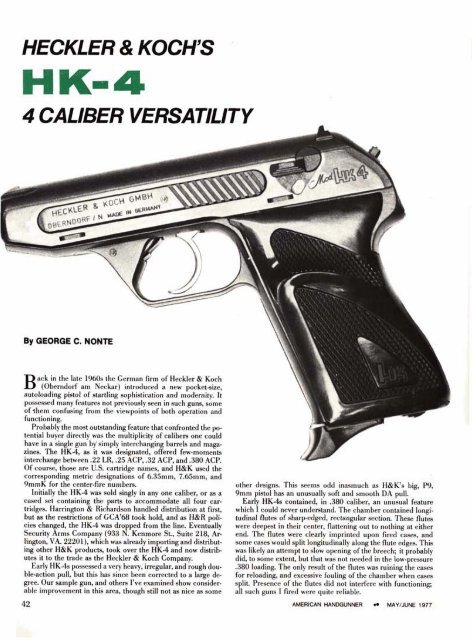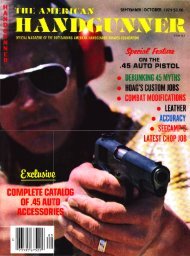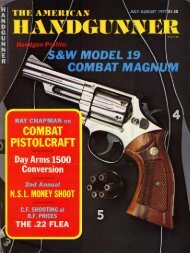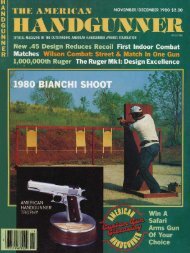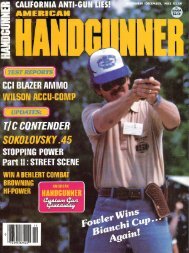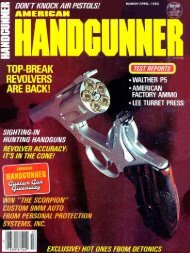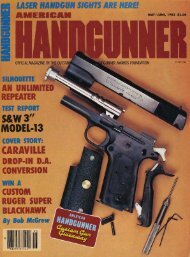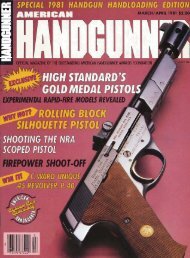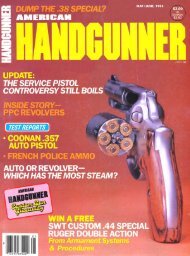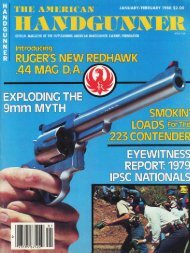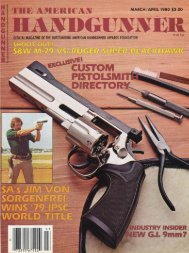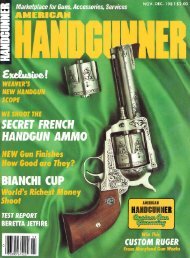HECKLER & KOCH'S4 CALIBER VERSATILITYBy GEORGE C. NONEack in the late 1960s the German firm of Heckler & KochB (Oberndorf am Neckar) introduced a new pocket-size,autoloading pistol of startling sophistication and modernity. Itpossessed many features not previously seen in such guns, someof them confusing from the viewpoints of both operation andfunctioning.Probably the most outstanding feature that confronted the potentialbuyer directly was the multiplicity of calibers one couldhave in a single gun by simply interchanging barrels and magazines.The HK-4, as it was designated, offered few-momentsinterchange between .22 LR, .25 ACP, .32 ACP, and .380 ACP.Of course, those are US. cartridge names, and H&K used thecorresponding metric designations of 6.35mm, 7.65mm, and9mmK for the center-fire numbers.Initially the HK-4 was sold singly in any one caliber, or as acased set containing the parts to accommodate all four cartridges.Harrington & Richardson handled distribution at first,but as the restrictions of GCA'68 took hold, and as H&R policieschanged, the HK-4 was dropped from the line. EventuallySecurity Arms Company (933 N. Kenmore St., Suite 218, Arlington,VA. 22201), which was already importing and distributingother H&K products, took over the HK-4 and now distributesit to the trade as the Heckler & Koch Company.Early HK-4s possessed a very heavy," irregular, and rough double-actionpull, but this has since been corrected to a large degree.Our sample gun, and others I've examined show considerableimprovement in this area, though still not as nice as someother designs. This seems odd inasmuch as H&K's big, P9,9mm pistol has an unusually soft and smooth DA pull.Early HK-4s contained, in .380 caliber, an unusual featurewhich I could never understand. The chamber contained longitudinalflutes of sharp-edged, rectangular section. These fluteswere deepest in their center, flattening out to nothing at eitherend. The flutes were clearly imprinted upon fired cases, andsome cases would split longitudinally along the flute edges. Thiswas likely an attempt to slow opening of the breech; it probablydid, to some extent, but that was not needed in the low-pressure.380 loading. The only result of the flutes was ruining the casesfor reloading, and excessive fouling of the chamber when casessplit. Presence of the flutes did not interfere with functioning;all such guns I fired were quite reliable.AMERICAN HANDQUNNER MAY/JUNE <strong>1977</strong>
ÂInset left are the four cartridges whichthe HK-4 will accept. Interchangeablebarrels and magazines allow the user tochoose .22 LR: .25ACP: .32ACP or .380ACP.Above, ~onte shoots the rimfire option.I don't know just when the flutes were dropped, but they arenot present on guns now being offered, and that is as it shouldbe.Today's HK-4 looks the same as before. It is best described asa blowback, pocket-size, autoloading pistol of conventional layout,with double-action capability, and incorporating advanceddesign and manufacturing features. At 6'18 inches long, 43/4 incheshigh, 1'14 inches wide, and with a 3'1s inch barrel, it is compactand easily handled and concealed. It possesses exceedingly fewsharp edges and protrusions, so is unlikely to snag on clothing inuse.The HK-4 is unusual in operation. With gun empty and magazineremoved, retracting the slide automatically engages theslide stop and the slide is held to the rear. With the magazineout, the slide may be run forward only by pulling the trigger; ifan empty magazine is inserted, the slide will automatically runforward; if a loaded magazine is inserted, the slide will also runforward, chambering the first cartridge and leaving the hammercocked. This will occur regardless of the position of the manualsafety. The hammer may then be lowered safely only by first engagingthe safety and then pulling the trigger; the safety shaftlowers the firing-pin head so it cannot be struck by the hammer.Further, a lug on the pin comes behind a shoulder in the slide soit cannot move forward. Moving the safety to "fire" positionAMERICAN HANDGUNNER MAY/JUNE <strong>1977</strong>then readies the gun for DA firing of the first shot; leaving it at"safe" prevents both firing and cocking by either DA or SA.This design combination makes it possible to safely carry theHK-4 "cocked and locked," or ready for instant DA use. However,the shape, location, and direction of movement (upward)of the safety combine to make it slow and inconvenient of usewhen carried cocked and locked. Nevertheless, it is one of thefew DA autos which allow this option. There is also a magazinesafety or disconnector which prevents firing or cocking whenthe magazine is withdrawn more than about '11s inch.This 'slide-forward-when-magazine-seats' feature aids in combatreloading, but the placement of the magazine catch at therear of the butt makes reloading still a relatively slow process. Itrequires two hands to remove the empty magazine, rather thanone as when the catch is left and rear of the trigger in Colt/Browning fashion. Relocating the catch behind the triggerwould make this one of the fastest-reloading auto pistols of all.All of this may sound a bit confusing, but with reasonable practice,operation of the HK-4 becomes as instinctive as that ofother - --- - - nistols.r -- - - -Aside from the unusual features mentioned, the HK-4 greatlyresembles the pre-war Mauser HSc. The barrelJslide unit is almostidentical, as is the barrel retaining system. Pressing downon the dismount latch inside the front of the trigger guard draws


